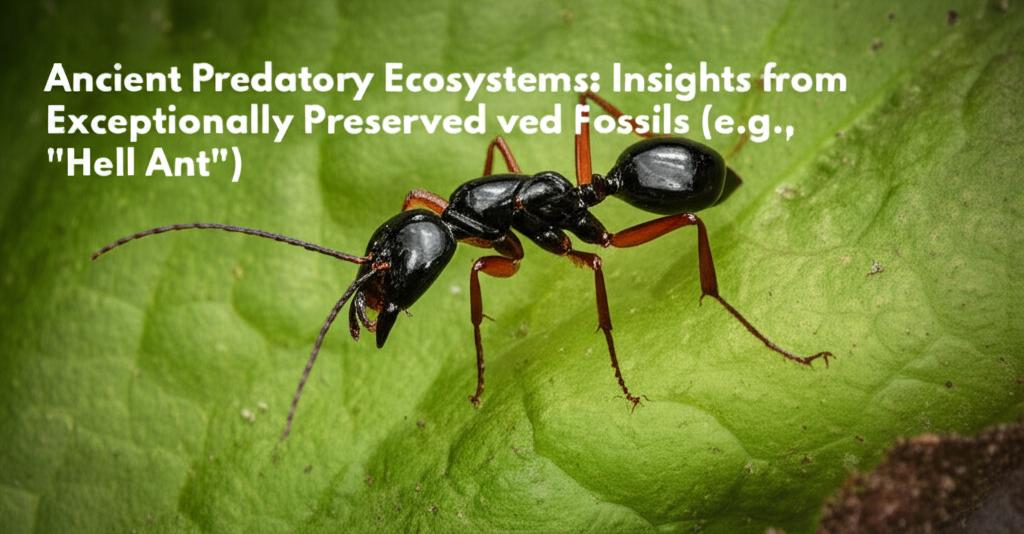Exceptionally preserved fossils, often found in amber or Burgess Shale-type deposits, offer an unparalleled window into ancient predatory ecosystems, revealing not just the skeletal structures but also soft tissues, "last meals," and even direct evidence of predator-prey interactions frozen in time. These remarkable finds allow scientists to reconstruct ancient food webs and understand the complex ecological dynamics that governed life millions of years ago.
One of the most striking examples of such preservation comes from Cretaceous amber, which has yielded creatures like the "hell ants" (Haidomyrmecinae). These extinct ants, distantly related to modern ants, possessed bizarre, scythe-like mandibles that moved vertically, a feature not seen in any living ant species. Some hell ant fossils, such as Ceratomyrmex ellenbergeri, have been found with a large, reinforced horn-like appendage on their heads (clypeus). It's hypothesized that these ants used their upward-striking mandibles in conjunction with this horn to pin or trap prey, possibly soft-bodied insects. The exceptional preservation in amber has allowed for detailed 3D reconstructions of their anatomy, offering crucial insights into their unique hunting strategies and the evolutionary experimentation that occurred within early ant lineages. One particularly stunning piece of amber even captured a hell ant, Ceratomyrmex zhueningi, in the act of grasping a Cretaceous cockroach nymph, providing direct evidence of its predatory behavior. This fossil confirmed that their specialized headgear and mandibles were indeed used to subdue prey.
Beyond hell ants, other amber inclusions have revealed a diverse array of ancient predatory arthropods. For instance, fossils of Слепняки (ancient assassin bugs) and lacewing larvae with their formidable sucking mouthparts provide glimpses into the insect-on-insect warfare of the Mesozoic Era. These fossils can show minute details like sensory hairs and fine cuticular structures, helping researchers infer their hunting techniques and sensory capabilities.
Moving beyond amber, exceptionally preserved fossils from marine environments, such as the Cambrian period's Burgess Shale in Canada and the Chengjiang biota in China, showcase some of Earth's earliest complex animal predators. Anomalocaridids, like Anomalocaris itself, were apex predators of their time, featuring large, grasping frontal appendages and a circular mouth with sharp plates. Fossils of these creatures sometimes contain trilobite fragments in their gut contents, directly indicating their prey. The detailed preservation of their eyes, gills, and musculature allows for a deeper understanding of their physiology and predatory adaptations in early Paleozoic seas.
Similarly, Mesozoic marine reptile fossils like ichthyosaurs and plesiosaurs are sometimes found with the preserved contents of their last meals—fish scales, cephalopod hooklets, and even smaller marine reptiles. These gut contents, along with evidence of bite marks on prey fossils, help scientists piece together the trophic relationships in ancient oceans. For example, some ichthyosaur fossils exhibit clear evidence of deep-diving adaptations, suggesting they hunted in darker, deeper waters.
The study of these "frozen moments" in the fossil record is crucial. It moves beyond simply identifying ancient species to understanding their behavior, their role in the ecosystem, and the evolutionary pressures that shaped them. Advanced imaging techniques, such as CT scanning and synchrotron microtomography, are increasingly being used to study these fossils non-destructively, revealing internal structures and minute details that were previously inaccessible. These technologies allow for more accurate reconstructions of extinct animals and their interactions, providing a clearer picture of the often brutal, yet fascinating, predatory dynamics that have driven evolution for hundreds of millions of years. By examining these ancient hunters and their victims, we gain a better appreciation for the complexity and interconnectedness of life throughout Earth's history.

